Feb-23-25
 | | KEG: By the time of this last-round game, Reggio was destined to finish in next-to-last (i.e., 19th) place, so he had little to play for. Mieses also had little at stake. He was certain to end with a negative score and nearly certain to end in 12th place. But just everybody else was beating up on Reggio in this tournament, so I guess he wanted to grab what he may have thought would be an easy point. He didn't seem to be making much of an effort and basically waited around for Reggio to blunder away the game. Mieses managed to reduce the game to a double-Rook ending (which can often be tricky) and then exploited some very weak endgame play by Reggio. Not one for the books.
1. e4 c5
Not surprisingly, Mieses avoided a potentially even double-King's pawn opening in favor of the more aggressive Sicilian Defense. 2. Nf3 e6
3. d4 cxd4
4. Nxd4 Nf6
5. Nc3 Nc6
6. NxN
Reggio would probably have been thrilled with a draw, and thus declined to play the more complicated 6. Ndb5 line. 6... bxN
7. e5 Nd5
8. Ne4
Eyeing the hole on d6:
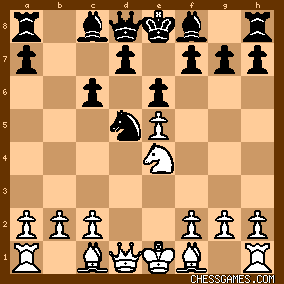
click for larger view8... f5?!
I might have assigned this move a "?" (the stronger 8...Qc7 seems obvious) but Emmanuel Lasker played this same move in defeating Yates at New York 1924, so perhaps this is a good way to beat up on an inferior player. 9. Nd6+
9. exf6 e.p. followed by 10. Nd6+ looks better. 9... BxN
10. exB
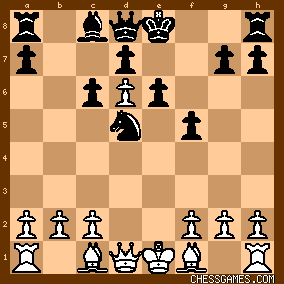
click for larger viewThe White pawn on d6, which was to remain there blocking the Black pawn on d7 for the balance of the recorded portion of this game (the score breaks off after move 36 by which time Mieses had an easily winning endgame). This doesn't look like much fun for Black, but Mieses seemed content to seek complications elsewhere on the board--a bizarre strategy in my book, though it worked for Mieses here. 10... 0-0
11. Be2 Qh4
This smells like a coffee-house move, and 11...c5 was surely stronger. But Mieses obviously had his own ideas on how to try to terrorize a weaker opponent. 12. c4 Nf6
13. g3 Qh3
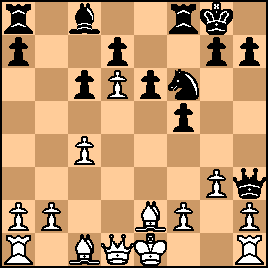
click for larger viewI'm not sure why Mieses went in for this. White can't castle yet, but that problem was easily solved by Reggio. 14. Bf1
Of course.
14... Qg4
Allowing Reggio to get a superior endgame, but anything else by Black here would be worse. 15. QxQ NxQ
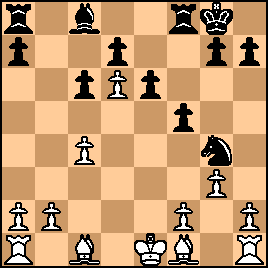
click for larger viewReggio was clearly better here. He has the two Bishops and his annoying pawn on d6. I would not be looking for this against a player I normally expect to beat. But this all worked out for Mieses, thanks to some upcoming poor endgame play by Reggio. So maybe Mieses did know what he was doing. |
|
Feb-24-25
 | | KEG: Post II
16. c5?
Fortifying the d-pawn of course has its merits, but Reggio first needed to deal with the Black Knight on g4 via 16. h3 or 16. f3. The text, however, was sufficient to play for equality and a draw, which may have been all Reggio wanted. 16... a5!
An excellent move by Mieses that unleashed the c8 Bishop on a6. 17. Bd2 Ba6
Now the Bishops came off and the game seemed to be heading for a draw. 18. BxB RxB
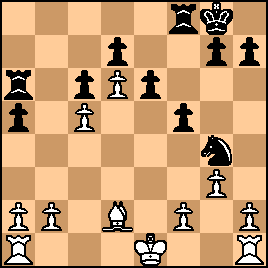
click for larger viewBlack still has his sickly d7 pawn, but he now has counter-play, including possible attacks on the White Queen-side pawns. 19. Bc3
19. f3 or 19. h3 may still have been better.
19... Nf6
20. BxN
Reggio now opted to reduce the contest to a double-Rook ending that White should theoretically be able to draw. 20... RxB
Since Mieses was playing to win, 20...gxB was stronger despite the doubled pawns, especially if he fancied some sort of King-side pawn advance. After the text, the position was:
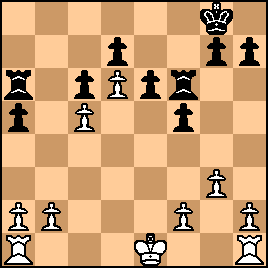
click for larger viewThis should almost certainly be a draw, but double-Rook endings can be dreadfully tricky, and Reggio quickly got outplayed. 21. f4
The King is a fighting piece in the endgame, and Reggio should probably have put his monarch to work with 21. Ke2. Alternatively, he could have played defense with 21. Rc1. The text, however, likely looked logical, and White should still be OK. 21... e5
A little trick by Mieses, but it leads to simplifying (and therefore probably drawing) exchanges. 21...a4 playing on the Queen-side was probably the best chance to try to make something out of nothing. In practice, however, Mieses' move worked just fine thanks to the coming collapse by Reggio. 22. fxe5 Re6
23. Kf2 Rxe5
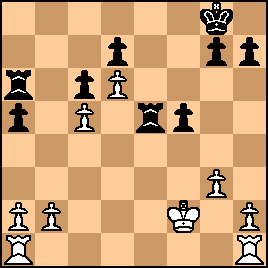
click for larger view24. Rac1?
Reggio was so fixated on defending his c-pawn that he missed the chance to obtain fully equalizing counter-play with either 24. Rae1 or 24. Rhe1. For example, if 24. Rac1 Rxc5 [24...Rd5 may be slightly better, but White should still be OK] 25. Re8+ Kf7 26. Rhe1 Rc2+ 27. Kf3 Rxb7 28. R1e7+ Kf6 29. Rf8+ Kg6 30. Rff7 Rxa2 31. Rxg7+ Kf6 32. Rxh7 with a clear draw for White. 24... Ra8!
The best way to try to exploit Black's small edge. 25. Rhe1 Rae8
26. RxR RxR
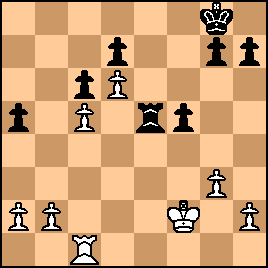
click for larger viewReggio may have reckoned that he could hold this position, especially with Black still saddled with his eyesore of a d-pawn. But single Rook endings can also be difficult, and Reggio with his next move transformed what probably was a theoretically drawn ending (which is still problematic for White) into a dead-lost position as I will discuss in my next post on this game. |
|
Feb-25-25
 | | KEG: Post III
27. b3?
This is more than just a miscalculation; it--unless Reggio was in desperate time trouble with the move-30 time control approaching--reflects a fundamental misunderstanding of the position. White cannot afford to trade off b-pawns since Black must win if he is left with an isolated a-pawn or a backward b-pawn. For these reasons, the counter-intuitive 27. a3 was better (though not a complete panacea). In fairness, I should point out that Stockfish does not agree with my assessment (it gives White's 32nd and 33rd moves as the crucial blunders. Nonetheless, I truly hate the text. 27... Kf7
28. a3
Continuing to pursue what I see as faulty strategy. 28... Ke6
29. b4
Giving Mieses what I think he wanted.
29... axb4
30. axb4
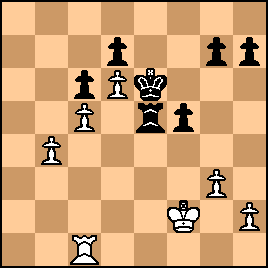
click for larger viewNow White (Reggio) has a weak backward b-pawn. As will be seen, once it falls, the game is over. 30... Re4
Yep.
31. Rb1
What else can White do!
31... Kd5
Ready to pounce if White tries b5.

click for larger view32. h3
Stockfish seems to think this was the losing move and prefers 32. h4. I like 32. h4 better too, but--perhaps because I do not have a computer for a brain--I am unable to fathom why that would save the day for White here. Presumably Stockfish wants to prevent 32...g5. But that ain't so great for Black, is it? 32... g5!?
At this point I knocked the pieces off the board. 32...g6 or 32...Kc4 or even Stockfish's alternative 32...h6 seem to preserve the win for Black. But now White has a glimmer of hope: 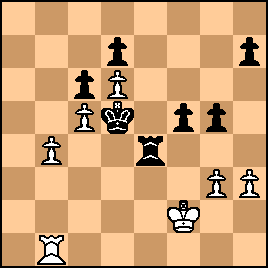
click for larger viewWhite is probably (at least in my mind) still lost, but 33. Rd1+ makes converting much more difficult, If then 33...Rd4 (probably best) then play might continue: 34. Re1 [blocking the file with 34...Re4 would just repeat the position after 35. Rd1+] Rxb4 35. Re7 with some counter-play for White. And if 33...Kc4, White has an even better chance of saving the day with 34. Ra1! Kxb4 35. Ra7 Kxc5 36. Rxd7 h6 37. Rh7 Kxd6 38. Rxh6+ But instead of 33. Rd1+, Reggio faltered again with: 33. Kf3?
And now his goose was cooked:
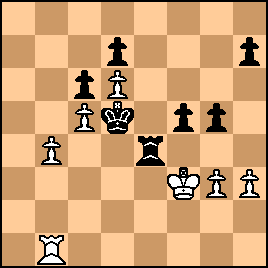
click for larger viewI will cover the conclusing decisive breakthrough by Mieses in my next post on this game. |
|
Feb-26-25
 | | KEG: Post IV
33... h5
Unnecessary and complicating what should be an easy win for Black. 33...h6 is one reasonable continuation. 33...g4+ is another good method. 34. Kf2 Kc4
Once again, this doesn't blow the win, but having played 33...h5, Mieses should have followed-up with 34...f4 or 34...h4. The text left:
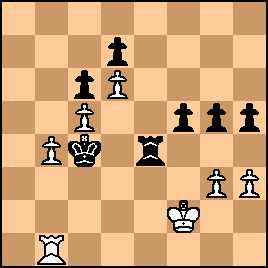
click for larger view35. Kf3?
Having played as he did, Reggio should probably have thrown caution to the wind and tried to counter-attack with 35. Ra1?!b4 36. Ra7. Play might then have continued 36...Kxc5 37. Rxd7 h4 38. gxh4 Rxh4 39. Rf7 Kxd6 40. Rxf5 Rxh3 41. Rxg5 and tried to draw the Rook vs. Rook and Pawn ending. Reggio's actual move was entirely hopeless:
35... Kb5
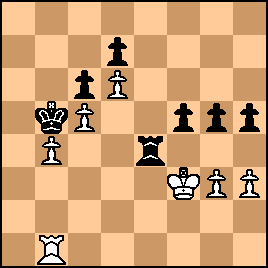
click for larger view36. Rb2
If Reggio intended to play on--as he obviously did--he might have tried a desperation counter-attack with 36. Ra1 (e.g., 36...g4+ 37. Kg2 Rxb4 38. Rf1 Rb2+ 39. Kg1 Kxc5 40. Rxf5+ Kxd6 42. hxg4 hxg4) hopeless as that almost certainly would have been. After the text, all he could look forward to was a slow lingering death: 36... Rxb4
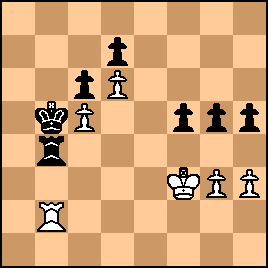
click for larger viewFor whatever reason, Reggio chose to play on here for another 18 or 19 moves. Mercifully, the balance of the score is not available. 0-1 |
|
Mar-10-25
 | | offramp: The great User: KEG has a superb chess book inside him. I would love to see a genuine actual printed book. Mr User: KEG could compile a 600-pager; one of those McFarland books that cost fifty quid+. Or he could make a Kindle for £0.01. That's an alternative. I always look forward to seeing KEG's next posts. He seems to follow the correct old system: <thesis> and <antithesis>. That's chess! That's checkmate - it's the end of the argument. KEG examines the games and reads the annotations; he makes his own opinion after making his own calculation. Sometimes, his favourite games are still being debated, after 120 years🤔💭. KEG's kibitzing is A+++. I am fain to interrupt his consecutive posts. I always wait until he reaches the final <1-0 or 0-1 or ½-½>. |
|
Mar-13-25
 | | KEG: <offramp> I am overwhelmed by your kind and generous comments. Thank you so much. At my age, and as I approach retirement with a host of medical issues to navigate and many things I still want to do (including some potentially dangerous mountain climbs), I'm not sure a book is going to happen. In the meantime, posting my thoughts on this wonderful site gives me comfort that if I have erred in my reasoning, one of the many very fine analysts on chessgames.com will show me what I have missed. So for now, being able to post here gives me endless joy and satisfaction. Thank you again. |
|
Mar-13-25
 | | moronovich: I´ll second <offramp> : Great analysis <KEG>. Glad they give you joy and comfort ! And say hello to them mountains from me. |
|
Mar-13-25
 | | perfidious: <KEG>, when the day comes to tackle those mountains, be safe--we want you back. |
|
Mar-14-25
 | | KEG: <offramp>
<moronovich>
<perfidious>
Gentlemen: I am overwhelmed.
Thank you all so much. I am delighted you all enjoy my posts/ |
|
Mar-14-25
 | | beatgiant: <KEG> You can add my voice to all those others. Truly A+++ kibitzing. Getting back to the game, I think the idea of 32. h4 is to prepare the counterplay via Ra1-Ra7-Rxd7, h5-h6 breaking up the kingside and liquidating a lot of pawns. Here's an example. 32. h4 Kc4 33. h5 Kb5 34. Ra1 Kxb4 35. Ra7 Kxc5 36. Rxd7 Rg4 37. h6 gxh6 38. Rxh7 Kxd6 39. Rxh6+ with a draw (tablebase). 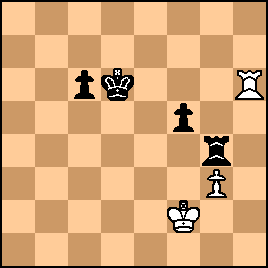
click for larger viewOf course, not all of that was forced, but I hope it illustrates the point behind 32. h4. |
|
| Mar-14-25 | | areknames: < beatgiant: <KEG> You can add my voice to all those others. Truly A+++ kibitzing. Ditto. Mountaineering, eh? Pls let us know if you decide to go ahead with those <potentially dangerous> climbs. All the best! |
|
Mar-14-25
 | | perfidious: In this type of ending, with both sides having weaknesses, piece activity is paramount. Naught but disaster lay in the passive line undertaken by Reggio. I too have the sense that <fishie>'s suggestion is motivated by trying to force Black to exchange as many kingside pawns as possible, while playing against d7, the one weakness in his game. |
|
Mar-14-25
 | | KEG: <beatgiant> I missed the point of 32. h4, but now--with the help of your superb analysis and the thoughts of <perfidious--my eyes have been opened. I see no improvement on the line you have given, and must conclude that Stockfish was correct and 32. h4 does indeed save the day. Well done. It is this sort of analysis--adding to my earlier efforts--that explains why I chose to offer my thoughts on this site. When I miss a crucial point, it is comforting to know that you, <perfidious>, and others will fill in and if necessary correct what I have posted. |
|
Mar-14-25
 | | KEG: <areknames> Many thanks. Rock and mountain climbing, like chess, helps make life worth living. There are risks in just about anything one chooses to do. Best to follow one's dreams rather than suffocate in a cocoon. Who knows, doing my best to engage in vigorous physical activity may actually prolong my life; just as studying and playing chess may help keep my aging brain from atrophy. |
|
|
|
|





































